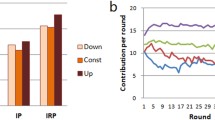Abstract
A direct mechanism of impact on the utility functions of agents in social and economic systems is studied. This mechanism is widely used in various forms by public authorities, commercial and non-profit organizations for reaching the desired behavior of individuals. A game-theoretic model of a hierarchical system composed of agents and super-individuals who can modify their utility functions is considered. The properties of equilibria in this model are investigated and the systems of different structure are compared with each other in terms of efficiency. It is established that the centralized management of super-individuals in certain conditions may be less effective in terms of maximizing public welfare than the decentralized schemes. In particular, this property can explain the successful development of peer-to-peer markets and decentralized financing mechanisms of projects in various spheres of human activity. Also, the presence of vertical competition effects in the system is demonstrated, which reduce the efficiency of equilibria with increasing the number of super-individuals.




Similar content being viewed by others
References
Bloch, A. Murphya’s Law. (Perigee, New York, 2003).
Vasin, A. A. Evolutionary Game Theory and Economics. Part 1. Optimality Principles and Models of Behavior Dynamics. Zh. Novoi Ekonom. Assots. no. 3-4, 10–27 (2009).
Vasin, A. A. Evolutionary Game Theory and Economics. Part 2. Stability of Equilibria. Special Features of Human Behavior Evolution. Zh. Novoi Ekonom. Assots. no. 5, 10–27 (2010).
Germeier, Yu. B. & Vatel’, I. A. Games with Hierarchical Vector Interests. Izv. Akad. Nauk SSSR, Tekh. Kibern. no. 3, 54–69 (1974).
Gorbaneva, O. I. & Ougolnitsky, G. A. The Price of Anarchy and Control Mechanisms in the Models of Concordance of Private and Public Interests. Mat. Teor. Igr Prilozh. 7(no. 1), 50–73 (2015).
Gorbaneva, O. I. & Ougolnitsky, G. A. Static Models of Coordination of Social and Private Interests in Resource Allocation. Autom. Remote Control 79(no. 7), 1319–1341 (2018).
Gumilev, L. N. Etnogenezis i biosfera Zemli (Ethnogenesis and the Biosphere of Earth). (Kristall, St. Petersburg, 2001).
Dawkins, R. The Extended Phenotype: The Long Reach of the Gene. (Oxford Univ. Press, Oxford, 1983).
Dawkins, R. The Selfish Gene. (Oxford Univ. Press, Oxford, 1989).
Kolesnik, G. V. Modelirovanie konkurentsii v ierarkhicheskikh sotsialano-ekonomicheskikh sistemakh (Competition Modeling in Hierarchical Socioeconomic Systems). (Lenand, Moscow, 2015).
Andersen, S. B. et al. The Life of a Dead Ant: The Expression of an Adaptive Extended Phenotype. Am. Naturalist 174(no. 3), 424–433 (2009).
Cornes, R. & Sandler, T. The Theory of Externalities, Public Goods and Club Goods. (Cambridge Univ. Press, Cambridge, 1996).
Fisher, C., Chin, L. & Klitzman, R. Defining Neuromarketing: Practices and Professional Challenges. Harvard Rev. Psychiatry 18(no. 4), 230–237 (2010).
Ingram, W.M., et al.Mice Infected with Low-Virulence Strains of Toxoplasma Gondii Lose Their Innate Aversion to Cat Urine, even After Extensive Parasite Clearance, PLoS One, 2013, vol. 8, no. 9. https://doi.org/10.1371/journal.pone.0075246
Johnson, S.K., et al.Risky Business: Linking Toxoplasma Gondii Infection and Entrepreneurship Behaviours across Individuals and Countries, Proc. of the Royal Society, Biological Sciences, 2018. https://doi.org/10.1098/rspb.2018.0822.
Katz, M. L. & Shapiro, C. Network Externalities, Competition, and Compatibility, Am. Econom. Rev. 75(no. 3), 424–440 (1985).
Kuti, M. & Madarasz, G. Crowdfunding, Public Finance Quart. 59(no. 3), 355–366 (2014).
Pagallo, U. & Durante, M. Three Roads to P2P Systems and Their Impact on Business Practices and Ethics. J. Business Ethics 90(no. 4), 551–564 (2009).
Vulkan, N., Astebro, T. & Sierra, M. F. Equity Crowdfunding: A New Phenomena. J. Business Venturing Insights 5(C), 37–49 (2016).
Author information
Authors and Affiliations
Rights and permissions
About this article
Cite this article
Kolesnik, G. Analysis of Equilibria in Systems with Endogenously Formed Utility Functions. Autom Remote Control 81, 1531–1544 (2020). https://doi.org/10.1134/S0005117920080147
Received:
Revised:
Accepted:
Published:
Issue Date:
DOI: https://doi.org/10.1134/S0005117920080147




